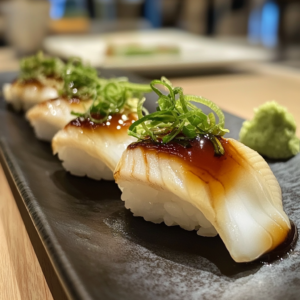What Makes Hamachi Sushi a Star in Japanese Cuisine?
If you’re a sushi enthusiast, you’ve likely encountered hamachi sushi—a dish revered for its tender texture and buttery flavor. Derived from young Japanese yellowtail, also called hamachi, this fish boasts a rich taste and delicate fat marbling that elevates it above other sushi types.
In Japanese culture, sushi represents balance and artistry. Hamachi sushi, in particular, strikes this balance with its simplicity and elegance. Let’s explore why it is a favorite in sushi bars worldwide and how you can enjoy it in your own kitchen.
For more on the history of sushi-making, visit Japan Guide. Learn sustainable fishing practices related to hamachi at Seafood Watch. Find sushi-making tips at Just One Cookbook.
What is Hamachi Sushi?
Hamachi sushi refers to sushi made with hamachi fish, also known as Japanese yellowtail or Seriola quinqueradiata. It is prized for its high-fat content, which results in a creamy and luxurious texture. Sushi chefs often use it for nigiri, sashimi, or rolls, showcasing its versatility.

The Difference Between Hamachi and Other Sushi Fish
Unlike lean fish like tuna or firm options such as salmon, hamachi stands out for its melt-in-your-mouth quality. This texture is due to the high concentration of healthy fats in the fish.
Why is Hamachi Sushi Popular?
- Buttery Flavor: Perfect for pairing with soy sauce or ponzu.
- Versatile Preparation: Ideal for raw or lightly seared presentations.
- Rich Texture: Adds depth to any sushi platter.
The Origin and Cultural Significance of Hamachi
In Japanese cuisine, hamachi symbolizes prosperity and good fortune, especially during celebrations. The fish’s availability throughout the year makes it a staple in sushi restaurants.
Historically, hamachi was reserved for special occasions in Japan, given its high fat content and exquisite flavor. Its global popularity soared as sushi spread worldwide in the 20th century, with hamachi sushi emerging as a gourmet favorite.
Different Styles of Hamachi Sushi
1. Nigiri
This classic sushi style features a slice of the fish atop seasoned sushi rice. Nigiri highlights the fish’s flavor with minimal ingredients.
2. Sashimi
Thinly sliced raw hamachi served without rice. Sashimi lets you experience the fish in its purest form.
3. Hamachi Maki Rolls
Rolled sushi with hamachi, rice, and seaweed. Common additions include cucumber, avocado, or green onions.
4. Seared Hamachi Sushi
Lightly torching hamachi enhances its umami flavor, giving the edges a smoky, caramelized taste.
5. Hamachi Tartare
Diced hamachi mixed with citrus, soy, and spices. Often served as an appetizer in fusion sushi restaurants.
Hamachi Sushi Nutrition
Hamachi is not just delicious—it’s also a nutritional powerhouse.
Key Nutritional Facts:
- Omega-3 Fatty Acids: Promote heart and brain health.
- High Protein: Supports muscle growth and repair.
- Vitamins: Rich in Vitamin D and B12.
- Low in Calories: Ideal for a balanced diet.
Comparing Hamachi to Other Sushi Fish
| Nutrient | Hamachi | Salmon | Tuna |
|---|---|---|---|
| Omega-3 (mg) | 1,500 | 1,200 | 1,000 |
| Protein (g) | 20 | 22 | 25 |
| Calories (kcal) | 146 | 208 | 130 |
How to Choose the Best Hamachi for Sushi
When selecting hamachi for sushi, freshness is paramount.
Tips for Choosing Sashimi-Grade Hamachi:
- Look for Bright Eyes: The fish should have clear, glossy eyes.
- Inspect the Flesh: Fresh hamachi is firm and translucent.
- Smell Test: It should have a mild ocean aroma, not a strong fishy smell.
- Buy from Reputable Sources: Always choose sashimi-grade fish.
Step-by-Step Recipe: Making Hamachi Sushi at Home
Ingredients:
- 200g sashimi-grade hamachi
- 2 cups sushi rice
- 1/4 cup rice vinegar
- 1 tbsp sugar
- 1 tsp salt
- Soy sauce, wasabi, and pickled ginger (for serving)
Instructions:
- Prepare Sushi Rice:
- Cook the rice according to the package instructions.
- Mix rice vinegar, sugar, and salt, then fold into the rice.
- Slice the Hamachi:
- Use a sharp knife to cut thin, even slices.
- Keep the fish chilled until serving.
- Assemble Nigiri:
- Wet your hands to shape rice into small mounds.
- Place a slice of hamachi on top, pressing gently.
- Wet your hands to shape rice into small mounds.
- Serve and Enjoy:
- Plate your sushi with soy sauce, wasabi, and pickled ginger.
Optional Variations:
- Add a brush of ponzu sauce for a citrusy twist.
- Torch the hamachi lightly for a smoky flavor.
Tips for Perfect Sushi
- Keep Everything Chilled: Sushi-grade fish must be kept cold to maintain freshness.
- Invest in a Good Knife: A sharp knife ensures clean cuts, preserving the texture of the fish.
- Master Rice Preparation: The balance of rice and vinegar is crucial for authentic sushi.
FAQs About Hamachi Sushi
What is Hamachi vs Yellowtail?
While hamachi refers to young Japanese yellowtail, older yellowtail is called buri. The terms are often used interchangeably outside Japan.
What Kind of Meat is Hamachi?
The meat is soft and rich, with a high fat content, making it perfect for sushi and sashimi.
Is Hamachi the Same as Tuna?
No. Hamachi is yellowtail, a separate species with a buttery flavor distinct from tuna.
Internal Links for Related Recipes
For more delightful recipes, explore these pages on our site: